The Knowledge and Art of Perfume A perspective on perfumery
The word "perfume" comes from two Latin words per, meaning "through" and fume, meaning "smoke". This suggests one early way of creating a sweet smell was by burning fragrant woods. Perfumes have certainly been used for thousands of years. Archaeologists who opened King Tutankhamen's tomb found pots of scented ointments. Early perfumes were made chiefly from scented resins, balsams, leafs, spices, and the wood of certain trees. The oils containing the scents of these plant substances are usually called essential oils.
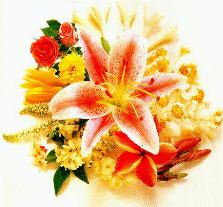
The first, distillation, was known to the Arabic people, who were the first to prepare rose water by distilling the petals of roses with water.
Another method is by expression, or squeezing. The peels of lemon, orange and bergamot are rasped and pressed, formerly by hand but now by machine.
The method of enfleurage, used for jasmine, depends on the absorption of perfume by fats. In maceration, a process used with most flowers, the petals are put in oil heated to about 65°C.
A modern way of extracting plants perfumes is by using a volatile solvent, such as petroleum ether or benzene.
To prepare a perfume, the perfumer chooses a basic scent and builds on it by mixing essential oils and fixatives that hold the perfume together, making the fragrance lasting. The most important of fixatives used to be musk from the male musk deer. Others are from the Civet cat, Castoreum, from the Canadian and Russian beaver; and Ambergris from the sperm whale.

During the 20th century progress in chemistry led to the introduction of many perfumery chemicals that the perfumer can use[now about 4,000 of them]. Now it is possible to produce close copies of flowers' oils with chemicals made from such starting materials as coal tar and benzene from crude oil.
The Art of Perfume
In the sounds there are mixed many smells, the strong smells of thousands of joss sticks, rays of
sunlight shine through the windows and cut clean columns through the smoke. The clouds of smoke float above in curls and thicken into the stink of the smell of burning candle wax, soft smells of fresh flowers and the pungent scent of the crowds sweat.
These smells escape from the room and outside crashes into the breeze and sunshine and the wind transports this smell higher, higher and higher..........
The legend of smell "passes through smoke"
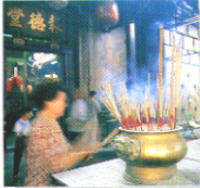
Imagine when we try to follow this smoke higher and higher. Nobody knows the smell of joss sticks and sacrifices that float to the sky and the smell blows around the sacred images in the mysterious temple. Even so the holy pictures on the shelves falls nobody knows "who" or "what" can receive this message and grant the wish sought. But human beings of this world strive to discover ways to contact that "something" with power greater than himself. This is one of the reasons for why man used smoke in ancient times to carry his wishes and demands to these higher beings. Later man found that he could use these and other smells or flowers for personal adornment.
In the heat wave of the desserts of Egypt we can see The Pyramids as the place that started to use smells where can find in the evidence written in stone in the dessert nation a special blend of such exotic smells in what many believe is the very first recorded perfume known as "Khaphi" by this Ancient Civilisation.
Khaphi, made by the Egyptians and used in religious rites to please the gods. When they preserved their Great leaders as the famous "Mummies", they used Khaphi and spices in the embalming of body of Mummy when taking out the heart , kidneys, lungs and everything in stomach etc. They believed the Khaphi and spices could preserve the Mummy for a long, long time, while the deceased waited for resurrection.
Ancient Egyptian priests used some fragrant woods and discovered these woods had fragrant volatile oils when they ground the wood into powders and mixed them with fragrant gums and resins and spices such as cinnamon, clove and others. (between 16-60 types). They called it Khaphi when they burned it during praying to the gods There is evidence that supports men and women of Egypt knew how to use these fragrant gums to smear over their body's to smell good, since 3,000 BC.
If we talk about many thousands of years ago in Egypt then it seems to be so very far from us now. But imagine the atmosphere of the Indian Temple in Silom Rd. Bangkok. You can remember the strong smell of joss sticks, benzoin gum and sometimes we can imagine the smell of the blood shed from men who have performed in the ceremonies "song-jow"
![]() mixed with the fresh smells of oranges and lemon, in the strict atmosphere of ceremony.
mixed with the fresh smells of oranges and lemon, in the strict atmosphere of ceremony.
Another example is the vegetarian ceremony in China in the tenth month mixed in the sound of firecrackers there are smells of thousands of joss sticks mixed with the burning of paper in the big jar. It seems like many ceremonies of China that we can see everywhere.
In Thai society, when they burnt joss sticks to offer to the Bhudda image. That easy example, we can see everywere. Buddha the smoke flows in peace in front of the Buddha image the atmosphere is heavy, there are candle light that gives a yellow glow. Many people believe that Thailand got this culture from India from "Khor khid khor khian''
![]() . Many believe the basis for this custom of using joss sticks comes from the oldest religions to please the sky and fire. In the encyclopedia of Sir Monia William joss sticks are the fragrance or the smell from fragrant gums "toob pa ya" it is a preposition from Sanskit that means through smoke (similar to the Latin root "par fumem")
. Many believe the basis for this custom of using joss sticks comes from the oldest religions to please the sky and fire. In the encyclopedia of Sir Monia William joss sticks are the fragrance or the smell from fragrant gums "toob pa ya" it is a preposition from Sanskit that means through smoke (similar to the Latin root "par fumem")
His Royal Highness Damrongrachanuphap explained in the book "The legend of Kreang Toh (the set of tables used to set the Buddha image and the offerings of candles, joss sticks and craft jar), the methods for burnt fragrances are 2 different ways, first we burnt fragrance wood, later we used joss sticks that we made from fragrance wood , because it's very comfortable.
The reason for burning sacrifices was that they believed that the fire cleaned and purified, and the smoke transported their offering and message to the gods. In the Holy Sanskrit book it explains about the value of fire ;
"...they are the angels who flout and invited the gods who stay in heaven to the earth, to receive the sacrifice, their message and grant their wish"
Ordinary people, men and women used perfume for personal adornment. Greece was the first nation to separate types of perfume, either for the religious rites to please the gods or for personal adornment. The era of the boom of perfume, started around the first two centuries of The Roman Empire. Later, it spread to Europe. In early times, they made perfumes from simple natural materials like flowers, leaves, branches etc. When they wanted to use perfume, they picked flowers or leaves to put in their hair or, they added them to water and used this water as "perfume".
King Nero of Rome was fascinated by perfume. When he walked, fragrant grasses lined the route. In his palace, the roof top could move and drop flowers and there was a small silver tube to spray perfume.
Louis 14th of France sometimes known as "The king of perfume". When there were ceremony in the town he would free pigeons that had perfume smeared on their wings. So that every person in the City could smell the perfume.
In Thailand, the King Rattanakhosin II was a monarch who was fascinated by perfume. There
is evidence from Sunthornphu's book "Nirat Phukoaw Tong"
"When close to the king we smelled perfume,
the smell was so good
When he died the smell disappeared,
and our fortune ended like the smell"
In his act, he was a famous writer, "Inoa"
"Order the servant to turn on the golden tube
that can spray the perfume of roses"
In Thai society ,Thai people have been known to use perfume for a long time.This is because in
Thailand, there are many plants that can make perfume. In the past when we pass the Thai style house, we could see the tiny basket that the flowers are in inside, hanged on the windows or the doors. When the wind blows ,you could smell them. Thai people can make perfume from local flowers like;
smells can disappear in just a few moments and are carried away in the breeze. After all, "Forever"
How we can me make these smells last forever?
"................Can you smell something? Not the strong smell of joss stick or burnt candle, the smell is strange, so good, mysterious, a smell that can crush the heart , later the smell is softer..softer... "
Sources of perfume.
In early age, human used the plants to make perfume. But not all the plants could make perfume. Some kinds don't have essential oils [we can find in flowers, leafs, branch etc.]
Jasmine and Roses [The queen of flowers], found in flowers.
Rosemary and Geranium, found in leaves.
Almond (fixed oil
![]() ) found in seeds, etc.
) found in seeds, etc.
Even if the same plant is grown in a different area, the smell changes so there are specific areas or sources that are best of each plant material used.
For example;
Rose that there many species but only 2 are really used for perfumery 1) Rosa Centifolia - Rose de Mai [from France or Egypt] - for Rose Absolute 2) and Rosa Damascena (from Bulgaria) for Rose Otto.
 Ylang ylang, the flower of flowers with a smell sweet and intoxicating, from Madacasca
Ylang ylang, the flower of flowers with a smell sweet and intoxicating, from Madacasca
Bergamot, from Calabria in Southern Italy.
The modern heart of perfumery is the famous town of Grasse in the Provence region of the South of France where many great quality flowers are cultivated for perfume such as jasmine, rose, violet, mimosa, narcissuss. The town is cradled by mountains making the soil and climate perfect for planting jasmin. At midday sea mist from the nearby Riviera on the Mediterranean bathes the town. Jasmine de Grasse Absolute is one the famous products extracted from Jasmin flowers of Grasse
The city of Tanta city in Egypt is another town where quality flowers like rose, jasmin, geranium, carnation, chamomile and marigold can be found.
Animal Sources of perfume materials
Many do not realise some of the materials used in perfume come from animal sources such as the whale, deer, beaver and wild cat.
Ambergris
is from the huge male Sperm Whale. The whale eats a lot of cuttlefish which have a sharp beak like bone that irritates its stomach. The whale produces a pathological
![]() substance to help cure the damage caused. When the whale produces a lot it forms into a mass and the whale expels it from the stomach into the sea. The mass floats in the sea for many months where the blood and fecal matter are washed away and the rich musk powdery odour develops. Eventually the mass is washed up on a shore somewhere to be discovered by beach visitors. If the whale is killed for meat then a very dirty, low quality form of Ambergris can be recovered from the stomach.
substance to help cure the damage caused. When the whale produces a lot it forms into a mass and the whale expels it from the stomach into the sea. The mass floats in the sea for many months where the blood and fecal matter are washed away and the rich musk powdery odour develops. Eventually the mass is washed up on a shore somewhere to be discovered by beach visitors. If the whale is killed for meat then a very dirty, low quality form of Ambergris can be recovered from the stomach.
 Civet
is the sticky very strong fecal smelling substance from the wild Civet Cat of Ethiopia, its produced by the cat to mark its territory and attract the opposite sex . We could recover Civet by scraping it from the trees where the cat has left traces but the more common way is to catch the cat and keep it in a small cage and wipe the civet from the glands or from where the cat has smeared it on the cage bars.
Civet
is the sticky very strong fecal smelling substance from the wild Civet Cat of Ethiopia, its produced by the cat to mark its territory and attract the opposite sex . We could recover Civet by scraping it from the trees where the cat has left traces but the more common way is to catch the cat and keep it in a small cage and wipe the civet from the glands or from where the cat has smeared it on the cage bars.
Castoreum
is from the Canadian Castoreum Beaver where it is somewhat of a pest
![]() . It is a sticky creamy coloured liquid from the organs
. It is a sticky creamy coloured liquid from the organs
![]() When the beaver is culled the organs are collected. As they dry out they darken to a cocoa colour. The original castoreum is not such a good smell but develops to a rich leather like note.
When the beaver is culled the organs are collected. As they dry out they darken to a cocoa colour. The original castoreum is not such a good smell but develops to a rich leather like note.
Musk
is from the male Tibetan Musk Deer, Moschus Moschiferus. It is a secretion found in an internal pouch near the abdomen. It is possible to remove the pouch without killing the deer but as the deer is very shy and hard to catch the most common method is, sadly, to kill it. The pouch is removed, dried and shipped as a "Musk Pod" it is probably the most expensive material used in perfumery.
The animal products are prized for their longer lasting attributes than materials from plants and have a fixative
![]() quality that is very important for perfume.
quality that is very important for perfume.
The cost of natural products
Perfume oils from nature, have limitations because of the cost of the raw plant material is expensive , a lot must be used and sometimes it is a hard to find material. For example when we want to make Rose Oil we need about 100 million flower petals to make just 1 pound of oil or to make 1 pound of Jasmin Absolute that mean we require 3-4 million of jasmine flowers.
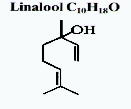 This is why man has tried to solve this problem and in his search he has found chemicals that have a smell or can be found in nature. He calls these "aroma chemicals". Nitrobenzene, was the first synthetic smell that the chemist discovered with the smell of almonds and was made from nitric acid plus benzene. He then found that he could recreate the smell of roses from lignite, alcohol and citronella oil. The smell of Carnation he found could be extracted from Clove Oil. Then smells from animal products could be replaced by chemicals that smell of ambergris, civet or musk. Now there are more than 3,000 aroma chemicals used by the perfumer and more than 1,000 natural essential oils and extracts. Aroma chemicals are often cheaper than the natural equivalents, but some are not as long lasting or as rich in odour.
This is why man has tried to solve this problem and in his search he has found chemicals that have a smell or can be found in nature. He calls these "aroma chemicals". Nitrobenzene, was the first synthetic smell that the chemist discovered with the smell of almonds and was made from nitric acid plus benzene. He then found that he could recreate the smell of roses from lignite, alcohol and citronella oil. The smell of Carnation he found could be extracted from Clove Oil. Then smells from animal products could be replaced by chemicals that smell of ambergris, civet or musk. Now there are more than 3,000 aroma chemicals used by the perfumer and more than 1,000 natural essential oils and extracts. Aroma chemicals are often cheaper than the natural equivalents, but some are not as long lasting or as rich in odour.
The methods for extracting essential oil.
In ancient times, man used perfume the most simple and direct ways, they smelling flowers, smearing oils from woods on their bodies etc. But there were limitations using the perfume like this, the smell couldn't stay for a long time, when seasons changed they couldn't find that flowers, they couldn't store or transport the materials so that the smell could be used when they wanted it.
Then when they roasted or burnt wood they noticed something like oil and used this for perfume. But this method can't be used for flowers but they found when they put the flowers in hot oil, the flowers can gave up their essential oil and was dissolved in the oil. When cooled the fat mixed with the essential oil could be used as a perfume which they called, "pomade". This process could be used for roses, ylang ylang and other flowers who's smell is not damaged by the heat.
It was found that essential oils from citrus fruits could be extracted by squeezing the peel
![]()
Man used these methods for thousands of years. Later, Arabians discovered the method of distilling
![]() essential oils from plants with water for example from the petals of flowers. Using this method, they could now extract far more essential oils from plants than before.
essential oils from plants with water for example from the petals of flowers. Using this method, they could now extract far more essential oils from plants than before.
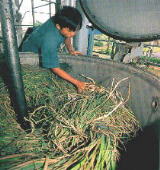 When the perfume spread to Europe, the French discovered two more methods for extracting essential oils from plant materials. "Enfleurage", the absorption of essential oils from petals onto solid fats and using volatile
When the perfume spread to Europe, the French discovered two more methods for extracting essential oils from plant materials. "Enfleurage", the absorption of essential oils from petals onto solid fats and using volatile
![]() solvents.
solvents.
In "Enfleurage" solid fats
![]() is layered onto sheets of glass then flowers are placed on the fat. As the flower produces essential oil (its perfume) then it is absorbed into the fat. When the flowers are exhausted then they are replaced with fresh flowers until the fat is saturated and can hold no more. The essential oil is then separated from the fat using alcohol.
is layered onto sheets of glass then flowers are placed on the fat. As the flower produces essential oil (its perfume) then it is absorbed into the fat. When the flowers are exhausted then they are replaced with fresh flowers until the fat is saturated and can hold no more. The essential oil is then separated from the fat using alcohol.
In solvent extraction flowers or other plant materials are put into a volatile solvent, such as petroleum ether, benzene or hexane. The solvent dissolves the essential oil, some waxes and colour hidden deep within the material. The spent flowers are filtered out and the solvent mixture is moved to a fresh container to evaporate off the solvent. When the solvent evaporates it leaves the essential oil waxes and colour behind, this solid mixture is called a "concrete". The essential oil can be separated from the concrete by using alcohol. Now this process is highly mechanised so that the quality can be controlled.
Thai-China Flavours and Fragrances Co. Ltd. (TCFF)
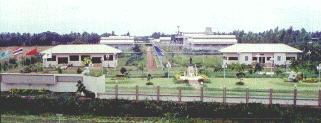
"TCFF is joint venture between Thai and China to produce essential oils and create perfume and flavours, until recently all of the1,600million Baht a year that Thailand spent on perfume and flavours had been imported.
"Our factory uses 2 methods for extracting essential oils.
"1) Distillation and 2) extraction with volatile solvents.
"Distillation is used for plants that have the essential oil in the leaves, branches or stems. The plant material is packed into the first tank and boiling water injected
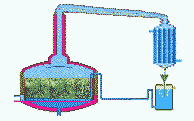
. The steam passes through the plant material and carries the essential oil out of the tank into a condenser [-5'c]. The steam condenses
"Extraction is used for flowers using a volatile solvent , the flowers are packed into a sealed tank above and the volatile solvent is pumped in. The solvent is pumped through the flowers many times, from ten to eighty hours to remove all of the oil. The solvent and essential oil mixture is sent to the concentrate tank to separate the essential oil from the solvent under vacuum

"The essential oil is collected and sent to the lab for final analysis."
" There are many raw materials that can be used to create new perfume formulas or to copy natural smells. The secret of perfume lies in the imagination that springs from knowledge. All the
windows in that room were closed, but the reason , not to imprison the old man in that room or the smell in the hundreds of bottles on the shelves. The reason is to stop the wind outside to escaping into the room."
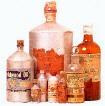
from the shelf and put a few drops into a small phial on the weighing scale.
"The balance can weigh one one thousandth of a gram, one millionth of a Kilogram. Now Mr. Zheng is trying to reproduce the smell of pineapple. Mr. Zheng is a flavourist
The old man continued, concentrating on his work, to the side of him on the table there was a formula sheet with a long list of chemicals and essential oils and numbers, a recipe for pineapple flavour.
Mr. Sattaporn translated the words of the old man who was speaking Chinese.
"To make just one we may use 10 different raw materials or maybe for some smells we may use up to 100!"
 The old man carefully shook the bottle, then taking a six inch long thin strip of blotting paper
The old man carefully shook the bottle, then taking a six inch long thin strip of blotting paper
"When we take this smell to the customer maybe he wants it more sweet, if they are satisfied then we pass this formula to the factory to produce bigger quantities. We have to be careful that "perfume"
"Every day, when we wake up, we used soap, toothpaste, shampoo, coffee, cream, yogurt etc. Many people didn't known these product have added perfume, it's not really the original smell of the product."
How many smells can you remember - the perfumer?
 When we open a the bottle of perfume, immediately our nose catches some smell, and then it disappears a few seconds later. When sprayed the smell changes, this smell may stay with us all day. Many people don't realise that in the bottle of perfume there could be 60 or more kinds of materials and probably don't know who made the perfume? Before we look at the answers, ask yourself, "How many smell , can I remember? Make a list, is it 10, 20 maybe as much as 50 or 100?
When we open a the bottle of perfume, immediately our nose catches some smell, and then it disappears a few seconds later. When sprayed the smell changes, this smell may stay with us all day. Many people don't realise that in the bottle of perfume there could be 60 or more kinds of materials and probably don't know who made the perfume? Before we look at the answers, ask yourself, "How many smell , can I remember? Make a list, is it 10, 20 maybe as much as 50 or 100?
Athaya Shompupong, she can remember 3,000 smells ! She is a famous perfumer in Thailand. " I connect every smell that I want to remember with everything else that I can see in my daily life. This smells like socks, like grass, like dogs hair etc."
"Perfumer" means a person who designs, creates the character of a perfume. It looks like exciting
and challenging work to make a dream or the imagination come true."
For convenience to help remember every smell, we can classify them into 9 groups
T/N > M/N > B/N
"The basic knowledge for making perfume; in one bottle of perfume, there are 3 smells. The first smell when we open the bottle we call the Top Note. For example citrus essential oils or small molecule aroma chemicals.. When the first smell disappears then we can smell the second smell that stays with us all day we call it the Middle Note. This smell contains the main body of this smell, the floral heart notes, spice and green notes. The last smell that we smell, after many hours is the Bottom Note, containing the fixative materials (the raw materials that grab the perfume together) such as cedar wood ambergris or civet.
In every bottle of perfume there were at least one from these feelings captured in the notes of the smell;
In the world of feelings and.... smells.
..........................at the bus stop, there are many smells, from the girl we can smell the cologne splashed on her body, the smell of cheap shampoo like kaffir limes. The smell of the perfumed tissue that the woman used to wipe her face, and the strong smell of curry on her hands. The bad smell from the road drifts over, the strange smell from fast food shop. A newcomer, a young man, has a fresh smell like someone who's just taken a bath after exercising. A fascinating smell wafts from the pretty woman, the smell of ylang ylang, that intoxicatingly sweet smell with musk that she used just before she left the office and ran for her bus. She leaves traces of the smell moments before it crashes with the warm draft from the bus as it pulls up, she mounts and the smell fades as she disappears with the bus..........
It was far, far away from Silom Rd., in time and place and technology in 17 A.D. in Kachanluk of Bulgaria, that the first time man captured the smell of roses in a bottle, until now when we look at the modern perfume still today.
Man used the perfume from that the little bottle, he could spray use drops of the perfume enough to create his world of smell. From the smoke and the water he could smell . These days we can see similar looking types of perfume, but still not enough to satisfy mans desire for new smells, and so he is always trying to discover more and more for his adornment.
What goes into a perfume or a cologne?
The difference is found basically in the level of perfume compound
![]() used in the product.
used in the product.
Extrait or Perfume contains 20-40% perfume compound.
Eau de toilette; contains 8-15% perfume compound.
Eau de cologne; contains 4-8% perfume compound.
Image & Marketing
The fascination for perfume has expanded to every corner of the world, the perfumer constantly trying to create new perfumes and smells for the heart and body. Michael Piatri, chairman of Chanel, has said about the business of perfume "Even if you produce a great perfume you are not assured that the perfume will sell like hot cakes because the business of perfume involves individuals personal adornment" No one dare to say "this is the perfume suitable for everyone "because the smell is the personal adornment, but there are many ways that we can used to attract the customer.
The way that perfume is presented is very important; for example in the advertising for Pleasures the set is decorated with pastel coloured flowers and woman wears a sweet tone coloured dress and has and her puppy dog asleep, snuggled up, beside her. Someone who sees this ad. imagines this perfume is soft sweet, natural, the colour of box is soft pink, the bottle and perfume is look clean, virgin, and when we open the bottle the scent is soft and sweet.
The look, the image of perfume is the first thing that attracts the customer. "When we use pink roses we anticipate the softness and sweetness we smell the perfume, if we used green that would mean freshness and freedom and no one will think this perfume will be sweet."
The perfumes name is another factor that can create the concept of the perfume. Many famous perfumes in some way involve the Royal Catherine Demesis who was infamous for using black magic and voodoo Poison by Christian Dior, Nombre Noire - "darkness" of Shiseido, Magie Noire - "black
magic" of Lancome, these name are influenced by her name. She and her sons managed to rule 3 kingdoms of Europe (Francoise 2nd of France, Charles 3rd of Sweden, Henry 3rd of Sweden), when she invaded Chernongso Palace, in Turan, France, she used poison to destroy her enemy and those she did not trust, later when she died they discovered many boxes of poison hidden in the library of the palace.
We categorise these perfume that used these names, the smell is of mystery, fascination and sensual attraction. Poison, strong, mysterious covered with the sweet narcotic smell of flowers. Magie Noire (black magic), fatal attraction, a smell strong with the mystery of the dark of the night.
By contrast, Fidji by Guy Laroche smells of freedom, fresh and cool like walking on the beach in Fidji Island, clean and pure.
The story of Chanel No. 5, that great classic perfume, created in 1921 by Earnest Beaux for Chanel. It is said that when he created the new perfume there were many bottles of samples on the shelf. Coco Chanel choose the best, bottle with a label No. 5. That day a landmark perfume was born.
In 1792, a young man of Cologne city in Germany was getting married, for the occasion a monk was requested to stay with the Mulhens family. The monk passed on a secret formula to make a perfume which the young Mulhens used to make a perfume for selling. When Emperor Napoleon invaded Cologne city, it is said he ordered his soldiers to find homes for officers to occupy, the soldiers discovered the Mulhens home where the house number, 4711 was marked with a circular sign. It is said when Napoleon saw this sign is he thought it was an omen of good fortune and the sign was used for his perfume that we now know to this day as 4711 Cologne.
![]()
What can you tell about a person from their perfume?
La Nuit, this perfume can indicate the stature of the woman who uses it, she is luxurious , high society, sweet, fruity and soft spicy.
Paco Rabanne, a man simple but classic, a smell aromatic, with the fresh smell of Geranium and soft
spicy notes.
Tenere, spices with the smell of fresh flowers that tells us this is a funny guy who loves nature and adventure.
Haute Couture Fashion houses see perfume as a type of fashion to accompany dresses and hair styles, and that is why the designer clothes houses often produce perfumes and cosmetics. Perfume is statement of fashion, style and self just like clothes.
How do we smell ?
When we breath in,
 if there are some smells in the air in the form of odourous molecules, the air and smell passes over the olfactory bulb,
if there are some smells in the air in the form of odourous molecules, the air and smell passes over the olfactory bulb,
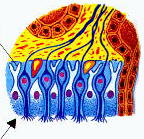 above nose, behind the eyes. There in an area of just 2.5 square centimeters, there are 50 million nerve cells each with 6-8 cilia
above nose, behind the eyes. There in an area of just 2.5 square centimeters, there are 50 million nerve cells each with 6-8 cilia
 (hair like structures with receptor sites) to receive the smell the cells send an electrical signal to the limbic system about 1 inch into the brain from the olfactory bulb towards the centre of the brain. The limbic system, which is highly involved with the emotional responses of man, interprets the meaning of each smell such as, what is the smell?, is it good or bad? etc., depending on the experience and instincts of each person. This operation uses around one quarter of a second.
(hair like structures with receptor sites) to receive the smell the cells send an electrical signal to the limbic system about 1 inch into the brain from the olfactory bulb towards the centre of the brain. The limbic system, which is highly involved with the emotional responses of man, interprets the meaning of each smell such as, what is the smell?, is it good or bad? etc., depending on the experience and instincts of each person. This operation uses around one quarter of a second.
Aromatherapy - The power of perfume.
Man has used perfume for personal adornment for a long time. Later, they discovered the perfume can used like medicine. "All perfumes are medicine" is Chinese proverb.
There were the evidence, Assyrians burnt marijuana when they were stressed. Indians used fragrant
wood to build temples in the belief that they can discover "Nirvana" in this place. Thai society boiled onions in water and used it for bathing when they had a cold.
Nowadays, we call the this method "Aromatherapy"
![]() used for some time overseas but the idea for Thai people is just a few years old.
used for some time overseas but the idea for Thai people is just a few years old.
There are 3 ways to used perfume for aromatherapy.
1) By smelling the perfume directly for example using a "burner" where the perfume oil is dropped into water heated by a candle. The perfume evaporates with the water and diffuses throughout the room.
2) By adding the perfume into water when taking a bath and, 3) By massaging the body with a fragrant oil.
We can used lavender for a headache , citrus oils for stress, eucalyptus oil for colds and wood oils when we wanted to calm down.